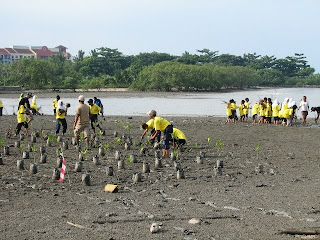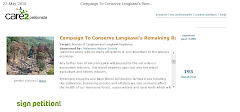 It started with my 3 little babies - Rhizophora, Ceriops Tagal & Brugeira Parviflora that were subjects of my experiment. They were picked up from the mangroves channel of Tanjung Rhu, Langkawi; sometime between March-April 2008. They were tested on their growth rate in the mud collected and being supplied with tap water. Their initial roots were measured and they did grow quite fast indeed (I was amazed).
It started with my 3 little babies - Rhizophora, Ceriops Tagal & Brugeira Parviflora that were subjects of my experiment. They were picked up from the mangroves channel of Tanjung Rhu, Langkawi; sometime between March-April 2008. They were tested on their growth rate in the mud collected and being supplied with tap water. Their initial roots were measured and they did grow quite fast indeed (I was amazed). A year later, they were comfortable sitting in the little plastic pot and still growing. However, not that plastic pot though. I guess is time for them to be where they should be - back to the intertidal zone. Where should they be planted??
I remembered the "nice" huge exposed western coast of Langkawi of Kuala Muda (next to Langkawi Langoon) and my babies can join the rest of the gang there.
I remembered the "nice" huge exposed western coast of Langkawi of Kuala Muda (next to Langkawi Langoon) and my babies can join the rest of the gang there.

Kuala Muda is a location whereby the fishermen dock their boats at the tiny jetty. There is a local food stall named "Warung Pais" where the fishermen hang out and gossip. As far as I know, back in August 2007, the island's celebrity naturalist and true conservationist, Irshad Mobarak, spearheaded Digi's Amazing Malaysia environmental project involving about 100 students all over Langkawi schools including Pulau Tuba. One of the project was mangroves planting at Kuala Muda. The aim is to plant these forest to protect that coastal area in case the next tsunami would hit. Yup, they walked, stomped and sank - into the thick soft mud. The  second picture is showing the big guy, Irshad with the school kids in yellow tees. I think the organiser would have learnt that darker colour for t-shirts would be suitable for such purpose.
second picture is showing the big guy, Irshad with the school kids in yellow tees. I think the organiser would have learnt that darker colour for t-shirts would be suitable for such purpose.
I can't recall the exact number of young seedlings planted but they were hundreds of them. My ex-colleagues of Wilderness Centre team, volunteered on that day.
The 12th April 2009 was the day I decided to release my babies. Followed me along was Aida, my Raleighian friend working on this island as naturalist. We waited for the low tide and then we went in. The Tok Penghulu of Kuala Muda was at "Warung Pais" and greeted us. He was curious. At that time, I only collected about 30 seeds together with my babies. They were mostly Rhizophora family. Rhizophora is usually much preferred as the front liners because this family is much hardier in standing against the big waves and currents. We enjoyed the nice feeling of sinking halfway into the mud and hmm... the mud texture... talcum powder paste.
 second picture is showing the big guy, Irshad with the school kids in yellow tees. I think the organiser would have learnt that darker colour for t-shirts would be suitable for such purpose.
second picture is showing the big guy, Irshad with the school kids in yellow tees. I think the organiser would have learnt that darker colour for t-shirts would be suitable for such purpose.I can't recall the exact number of young seedlings planted but they were hundreds of them. My ex-colleagues of Wilderness Centre team, volunteered on that day.
The 12th April 2009 was the day I decided to release my babies. Followed me along was Aida, my Raleighian friend working on this island as naturalist. We waited for the low tide and then we went in. The Tok Penghulu of Kuala Muda was at "Warung Pais" and greeted us. He was curious. At that time, I only collected about 30 seeds together with my babies. They were mostly Rhizophora family. Rhizophora is usually much preferred as the front liners because this family is much hardier in standing against the big waves and currents. We enjoyed the nice feeling of sinking halfway into the mud and hmm... the mud texture... talcum powder paste.


There they are now "in the wild outdoor" away from the comfort zone. Back to where they are meant to be, the mud and salty water. Go forth, grow and ... propagate... We need more of you than homosapiens.







No comments:
Post a Comment